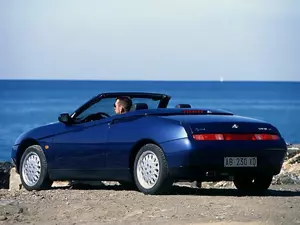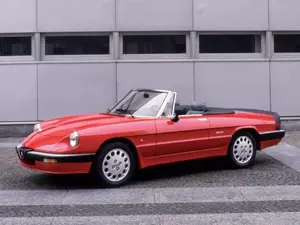| Vehicle | Precise engine size | Difference from world average | Engine size to consumption ratio | Horsepower from 1 L | Engine size to 100 kg of weight |
|---|---|---|---|---|---|
| 2.2 JTS |
2.2 L (2198 cc) |
6.3% smaller | 88 cc to 1 mpg | 84 hp from 1 L | 147 cc to 100 kg |
| 2.4 JTDM 20V |
2.2 L (2198 cc) |
6.3% smaller | 73 cc to 1 mpg | 91 hp from 1 L | 147 cc to 100 kg |
| 3.2 V6 Q4 |
3.2 L (3195 cc) |
36.2% bigger | 168 cc to 1 mpg | 81 hp from 1 L | 178 cc to 100 kg |
| Vehicle | 2.2 JTS |
|---|---|
| Precise engine size | 2.2 L (2198 cc) |
| Difference from world average | 6.3 smaller |
| Engine size to consumption ratio | 88 cc to 1 mpg |
| Horsepower from 1 L | 84 hp from 1 L |
| Engine size to 100 kg of weight | 147 cc to 100 kg |
| Vehicle | 2.4 JTDM 20V |
| Precise engine size | 2.2 L (2198 cc) |
| Difference from world average | 6.3 smaller |
| Engine size to consumption ratio | 73 cc to 1 mpg |
| Horsepower from 1 L | 91 hp from 1 L |
| Engine size to 100 kg of weight | 147 cc to 100 kg |
| Vehicle | 3.2 V6 Q4 |
| Precise engine size | 3.2 L (3195 cc) |
| Difference from world average | 36.2 bigger |
| Engine size to consumption ratio | 168 cc to 1 mpg |
| Horsepower from 1 L | 81 hp from 1 L |
| Engine size to 100 kg of weight | 178 cc to 100 kg |

| Vehicle | Precise engine size | Difference from world average | Engine size to consumption ratio | Horsepower from 1 L | Engine size to 100 kg of weight |
|---|---|---|---|---|---|
| 1.8 i 16V T.Spark |
1.75 L (1747 cc) |
25.5% smaller | - | 82 hp from 1 L | 125 cc to 100 kg |
| 2.0 i 16V T.Spark |
1.97 L (1970 cc) |
16% smaller | 76 cc to 1 mpg | 76 hp from 1 L | 141 cc to 100 kg |
| 2.0i 16V T.Spark |
1.97 L (1970 cc) |
16% smaller | - | 79 hp from 1 L | 141 cc to 100 kg |
| 2.0 i V6 TB |
2 L (1997 cc) |
14.9% smaller | - | 100 hp from 1 L | 143 cc to 100 kg |
| 2.0 JTS |
1.97 L (1970 cc) |
16% smaller | 76 cc to 1 mpg | 84 hp from 1 L | 141 cc to 100 kg |
| 3.0 i V6 24V |
2.96 L (2959 cc) |
26.1% bigger | - | 74 hp from 1 L | 211 cc to 100 kg |
| 3.2 i V6 24V |
3.18 L (3179 cc) |
35.5% bigger | 177 cc to 1 mpg | 75 hp from 1 L | 212 cc to 100 kg |
| 3.0 i V6 |
2.96 L (2959 cc) |
26.1% bigger | 118 cc to 1 mpg | 65 hp from 1 L | 211 cc to 100 kg |
| Vehicle | 1.8 i 16V T.Spark |
|---|---|
| Precise engine size | 1.75 L (1747 cc) |
| Difference from world average | 25.5 smaller |
| Engine size to consumption ratio | - |
| Horsepower from 1 L | 82 hp from 1 L |
| Engine size to 100 kg of weight | 125 cc to 100 kg |
| Vehicle | 2.0 i 16V T.Spark |
| Precise engine size | 1.97 L (1970 cc) |
| Difference from world average | 16 smaller |
| Engine size to consumption ratio | 76 cc to 1 mpg |
| Horsepower from 1 L | 76 hp from 1 L |
| Engine size to 100 kg of weight | 141 cc to 100 kg |
| Vehicle | 2.0i 16V T.Spark |
| Precise engine size | 1.97 L (1970 cc) |
| Difference from world average | 16 smaller |
| Engine size to consumption ratio | - |
| Horsepower from 1 L | 79 hp from 1 L |
| Engine size to 100 kg of weight | 141 cc to 100 kg |
| Vehicle | 2.0 i V6 TB |
| Precise engine size | 2 L (1997 cc) |
| Difference from world average | 14.9 smaller |
| Engine size to consumption ratio | - |
| Horsepower from 1 L | 100 hp from 1 L |
| Engine size to 100 kg of weight | 143 cc to 100 kg |
| Vehicle | 2.0 JTS |
| Precise engine size | 1.97 L (1970 cc) |
| Difference from world average | 16 smaller |
| Engine size to consumption ratio | 76 cc to 1 mpg |
| Horsepower from 1 L | 84 hp from 1 L |
| Engine size to 100 kg of weight | 141 cc to 100 kg |
| Vehicle | 3.0 i V6 24V |
| Precise engine size | 2.96 L (2959 cc) |
| Difference from world average | 26.1 bigger |
| Engine size to consumption ratio | - |
| Horsepower from 1 L | 74 hp from 1 L |
| Engine size to 100 kg of weight | 211 cc to 100 kg |
| Vehicle | 3.2 i V6 24V |
| Precise engine size | 3.18 L (3179 cc) |
| Difference from world average | 35.5 bigger |
| Engine size to consumption ratio | 177 cc to 1 mpg |
| Horsepower from 1 L | 75 hp from 1 L |
| Engine size to 100 kg of weight | 212 cc to 100 kg |
| Vehicle | 3.0 i V6 |
| Precise engine size | 2.96 L (2959 cc) |
| Difference from world average | 26.1 bigger |
| Engine size to consumption ratio | 118 cc to 1 mpg |
| Horsepower from 1 L | 65 hp from 1 L |
| Engine size to 100 kg of weight | 211 cc to 100 kg |

| Vehicle | Precise engine size | Difference from world average | Engine size to consumption ratio | Horsepower from 1 L | Engine size to 100 kg of weight |
|---|---|---|---|---|---|
| 2000 |
1.96 L (1962 cc) |
16.4% smaller | - | 64 hp from 1 L | 151 cc to 100 kg |
| 1600 |
1.57 L (1567 cc) |
33.2% smaller | 65 cc to 1 mpg | 69 hp from 1 L | 131 cc to 100 kg |
| 2000 Veloce |
1.96 L (1962 cc) |
16.4% smaller | - | 64 hp from 1 L | 151 cc to 100 kg |
| Vehicle | 2000 |
|---|---|
| Precise engine size | 1.96 L (1962 cc) |
| Difference from world average | 16.4 smaller |
| Engine size to consumption ratio | - |
| Horsepower from 1 L | 64 hp from 1 L |
| Engine size to 100 kg of weight | 151 cc to 100 kg |
| Vehicle | 1600 |
| Precise engine size | 1.57 L (1567 cc) |
| Difference from world average | 33.2 smaller |
| Engine size to consumption ratio | 65 cc to 1 mpg |
| Horsepower from 1 L | 69 hp from 1 L |
| Engine size to 100 kg of weight | 131 cc to 100 kg |
| Vehicle | 2000 Veloce |
| Precise engine size | 1.96 L (1962 cc) |
| Difference from world average | 16.4 smaller |
| Engine size to consumption ratio | - |
| Horsepower from 1 L | 64 hp from 1 L |
| Engine size to 100 kg of weight | 151 cc to 100 kg |